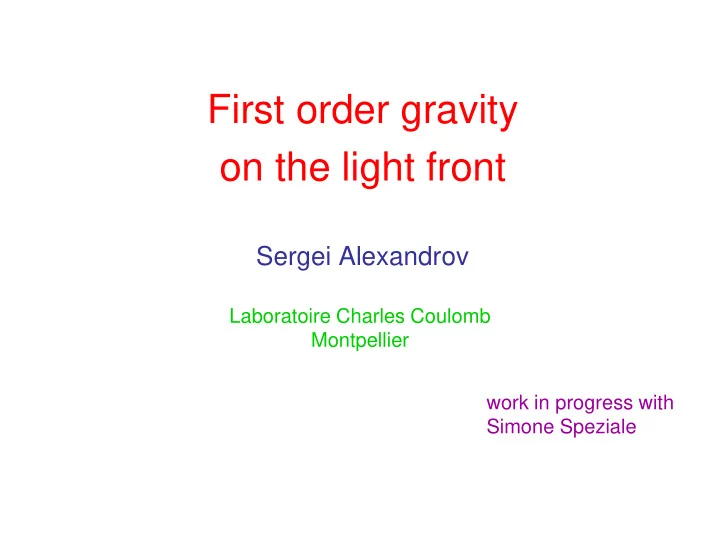

First order gravity on the light front Sergei Alexandrov Laboratoire Charles Coulomb Montpellier work in progress with Simone Speziale
Light Front Light cone coordinates: Main features: • Triviality of the vacuum – energy – momentum • Non-trivial physics of zero modes • Importance of boundary conditions at • Presence of second class constraints linear in velocities
Gravity on the light front • Sachs(1962) – constraint free formulation null vectors • conformal metrics on • intrinsic geometry of • extrinsic curvature of • Reisenberger – symplectic structure null foliation on the constraint free data • Torre(1986) – canonical formulation in the metric formalism • Goldberg,Robinson,Soteriou(1991) canonical formulation in – Inverno,Vickers(1991) the complex Ashtekar variables constraint algebra becomes a Lie algebra We want to analyze the real first order formulation on the light front • constraint free data exact path integral ? • issue of zero modes • Speziale,Zhang(2013) – null twisted geometries
Technical motivation In tetrad formalism the null condition can be imposed in the tangent space 3+1 decomposition of the tetrad shift lapse spatial metric Used in various approaches to determines the nature of the foliation quantum gravity (covariant LQG, spin foams…) spacelike spacelike lightlike timelike light front formulation Perform canonical analysis for the real first order formulation of general relativity on a lightlike foliation
Massless scalar field in 2d Solution: Light front formulation Primary constraint Hamiltonian is of second class Stability condition: first class Identification: zero mode • the phase space is one-dimensional Conclusions: • the lost dimension is encoded in the Lagrange multiplier
Massive theories One generates the same constraint but different Hamiltonian inhomogeneous Stability equation condition: The existence of the zero mode contradicts to the natural boundary conditions In massive theories the light front constraints do not have first class zero modes In higher behave like dimensions: massive 2d case dim. of num. of deg. phase space = On the light front : of freedom
First order gravity (spacelike case) Canonical variables: – normal to the foliation Fix Linear simplicity constraints Hamiltonian is a linear combination of constraints 3 1st class 6 2d class secondary constraints dim. of phase space = 2 × 18 – 2(3+3+1)-(3+9+6)=4
Hamiltonian analysis on the light front Canonical variables: Light front condition Linear simplicity constraints Hamiltonian is a linear combination of constraints 2 7 where The Hamiltonian constraint becomes second class secondary constraints + equation fixing the lapse
Tertiary constraints The crucial observation: and induced metric on the foliation has 2 null eigenvectors Projector on the null eigenvectors There are two tertiary constraints Stabilization procedure stops due to
Summary List of constraints: Gauss Gauss spatial primary secondary tertiary Hamiltonian preserving rotating diffeos simplicity simplicity First class Second class 4 3 2 1 9 2 2 6 2 1 4 Lie algebra 4 2 dim. of phase space = 2 × 18 – 2(4+3)-(2+1+9+6+2)=2 as it should be on the light front
Zero modes The zero modes of constraints are determined by equations fixing Lagrange multipliers Potential first class constraints: not expected to generate zero modes homogeneous equations
Zero modes time diffemorphisms independent of 1. Gauge transformation Light front condition The zero mode corresponds to the residual gauge freedom 2. of the null foliation would generates shifts of the spin-connection not changing the tetrad cannot be a gauge generator There are no (local) zero modes providing additional data needed to fix a solution
Some future directions • Better understanding of the zero modes? • What are the appropriate boundary conditions along ? • Can one solve (at least formally) all constraints? • What is the right symplectic structure (Dirac bracket)? • Can this formulation be applied to quantum gravity problems?
Recommend
More recommend